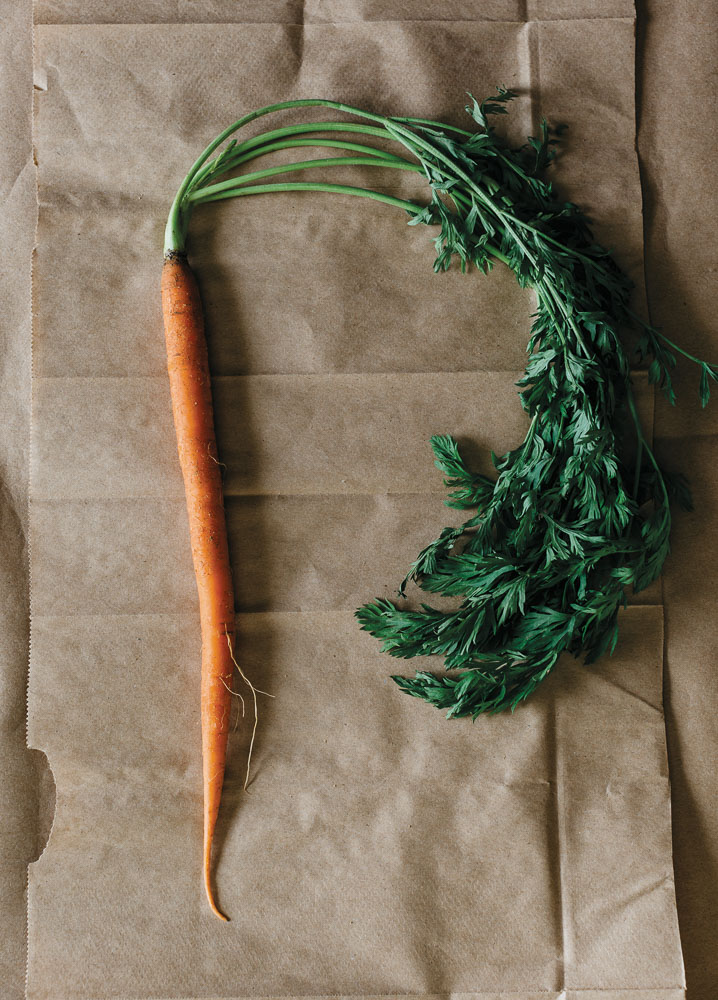One Ingredient: Carrots
Photo by Michael Piazza / Styled by Catrine Kelty
Carrots are pretty standard, vegetable-wise. They’re cut into spears to serve with dip, miniaturized and bagged for kids’ lunchboxes, and floated among the noodles in Mom’s chicken soup. They flavor the base of nearly every broth and stew recipe, along with their partners in the holy trinity of stock-making, the ever-present onion and celery. We all know how good they are for us; loaded with beta carotene, they’ll help us see in the dark, or so our grandmothers told us, and they’re low in calories and high in dietary fiber. But unless they’re grated in a salad or folded into a cake, they’re not often the center of attention. They’re just sort of… there. Enjoyed, but not fawned over.
That sentiment is changing, thankfully. Farmers are bringing back heirloom varieties to market, with reds, yellows, whites, and purples joining the bright orange carrots we’re used to. Market tables are laden with a bright spectrum of carrots, with brilliant green tops proving freshness and quality. Rainbow carrots are even available commercially in some supermarkets, bagged and shipped from California, ready to use all year long. And chefs are giving them their due: vegetables in general are having a moment, with farm-to-table restaurants reducing the amount of meat on menus in favor of interesting heirloom vegetables, a role-reversal likely to continue in the wake of the World Health Organizations’s dire warning that eating meat will kill us all. At Blue Hill in New York, Chef Dan Barber even dressed a whole roasted carrot with lamb sauce, rather than the other way around, altering the ratio of meat-to-veg towards a far more sustainable—and healthful—way of eating.
Local farm carrots—or better yet, ones you’ve grown in your own garden—are at their best in the fall and early winter. When the weather cools in late October, the carrots get sweeter and their sugars are concentrated, so some farmers will wait until after the first few frosts, mid-November in some cases, to pull them. Refrigerated, fresh carrots will last for months, so a huge, late fall harvest can be stored and sold at weekly winter markets, bringing much-needed income to a farm in its off season. Many farms discount bulk bags of carrots at late fall markets, so customers with extra fridge space can stock up and enjoy local carrots all winter long.
After picking up my end-of-season haul of storage carrots, I needed some fresh recipes to add to my favorites: all winter long, I make puréed carrot soups, curried carrots with red lentils, and mashed carrots with cilantro and lime, but I was ready for something new. I asked four local chefs for their take on carrots, and got some incredible recipes. From Flour’s Joanne Chang comes a carrot cake sweetened with fruit and juices—you’ll never miss the refined sugar. Jamie Bissonnette of Toro and Coppa sent a recipe that began by igniting some hay and smoking the carrots while they roasted; I omitted that step when adapting it for the home cook, but instructions are included for the brave ones who’d like to try their hand at oven-smoking. Colleen Suhanosky of Rifrullo Café sent a carrot mac-and-cheese that every parent should make immediately; brightly orange, it mimics the boxed stuff, but is so much better and definitely kid-approved. And from Ben Elliott of Saltbox Kitchen comes a recipe for carrot-potato latkes; the carrots’ natural sweetness make a delicious alternative to the traditional all-potato cakes, especially when topped with applesauce or sour cream. Hit your local market and stock up, then spend your winter making carrots the star of your kitchen.





